78th Fighter Group
The 78th Fighter Group (78 FG) is an inactive United States Air Force unit. It was last assigned to the 78th Fighter Wing, at Hamilton Air Force Base, California. It was inactivated on 1 February 1961.
| 78th Fighter Group | |
|---|---|
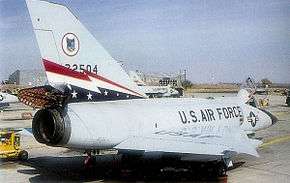 F-106 Delta Dart of the group's 84th Fighter-Interceptor Squadron[note 1] | |
| Active | 1942–1945, 1946–1952, 1955–1961 |
| Country | |
| Branch | |
| Type | Air Defense |
| Role | Fighter Interceptor |
| Part of | Air Defense Command |
| Motto(s) | Above the Foe |
| Insignia | |
| Current form of the group emblem | 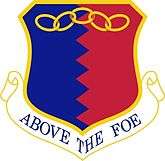 |
| Original form of the group emblem as approved 26 September 1942[1] |  |
During World War II the group was an Eighth Air Force fighter unit stationed in England assigned primarily to RAF Duxford. It claimed 338 air-to-air and 358 air-to-ground aircraft destroyed. It flew its last mission on 13 April 1945.
History
World War II
The 78th Fighter Group was activated at Baer Field, IN as the 78th Pursuit Group in January 1942, receiving its cadre from the 14th Fighter Group.[2] and re-designated as a fighter group four months later. It initially trained for combat with P-38s and served as part of the west coast air defense organization.[1] It moved to England in November 1942 and was assigned to Eighth Air Force. The group lost its P-38s, and most of its pilots, in February 1943 when they were assigned to the Twelfth Air Force for service in the North African campaign.[1]
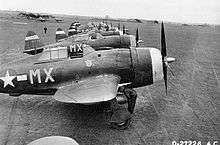
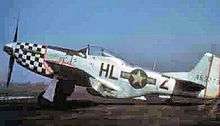
The group was reassigned to Duxford airfield in April 1943 and reequipped with Republic P-47 Thunderbolts.[1] Aircraft of the group were identified by a black/white chequerboard pattern.--
The group consisted of the following squadrons:
- 82d Fighter Squadron (MX)
- 83d Fighter Squadron (HL)
- 84th Fighter Squadron (WZ)
From Duxford, the 78th flew many missions to escort Boeing B-17 Flying Fortress and Consolidated B-24 Liberator bombers that attacked industries, submarine yards and docks, V-weapon sites, and other targets on the Continent.[1] In 1943, the group had the first American ace in Eighth Air Force.[3] The group also claimed a victory over a German Messerschmitt Me 262 jet fighter.[4] The unit also engaged in counter-air activities and on numerous occasions strafed and dive-bombed airfields, trains, vehicles, barges, tugs, canal locks, barracks, and troops.[1]
In addition to other operations, the 78th participated in the intensive campaign against the German Air Force and aircraft industry during Big Week, 20–25 February 1944 and helped to prepare the way for the invasion of France.[1] The group supported the landings in Normandy in June 1944 and contributed to the breakthrough at Saint-Lô in July.[1]
The group converted to North American P-51 Mustangs in December 1944[1] and participated in the Battle of the Bulge, from December 1944 to January 1945. It also supported the airborne assault across the Rhine in March.
The 78th Fighter Group received a Distinguished Unit Citation (DUC) for activities connected with the Operation Market-Garden combined ground and airborne attack through on the Netherlands in September 1944 when the group covered troop carrier and bombardment operations and carried out strafing and dive-bombing missions.[1] It suffered its heaviest casualties of the war in this operation.[5] The group received a second DUC for destroying numerous aircraft on five airfields near Prague and Pilsen on 16 April 1945.[1]
The 78th Fighter Group returned to Camp Kilmer New Jersey and October 1945 and was inactivated on 18 October.[1]
Cold War
Occupation of Germany
The 78th FG was reactivated in Germany on 20 August 1946, replacing the 368th Fighter Group (which was inactivated, redesignated the 136th Fighter Group, and allotted to the National Guard) at AAF Station Straubing, Germany and flew the former 368th's P-47 Thunderbolts from the airfield. The group was reactivated due to the Air Force's policy of retaining only low-numbered groups on active duty after the war.
In Germany the group was assigned to the United States Air Forces in Europe's XII Tactical Air Command for duty with the occupation force. The group was assigned to AAF Station Straubing, The group was transferred, without personnel and equipment, to Mitchel Field, New York in June 1947.[1]
Air Defense of the United States
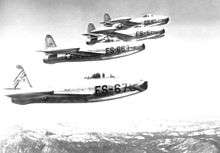
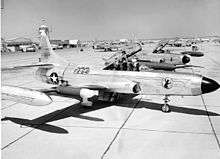
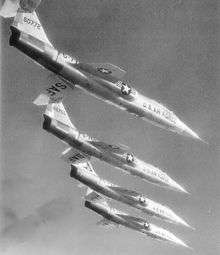
At Mitchel, the group remained active and was assigned to Air Defense Command (ADC). The group was manned with a small cadre of personnel,[1] being equipped with a few P-51D Mustangs. On 16 November 1948, the 78th was reassigned to Hamilton AFB, California where it was assigned to ADC's Fourth Air Force. At that time the 78th Fighter Wing was established under Hobson Plan, and the 78th Fighter Group became the operational component of the wing, controlling its flying resources.
On 1 March 1949, the 78th Fighter Group received the first of the new production F-84 Thunderjets,[6] with these aircraft going to the 82d, 83d and 84th Fighter Squadrons. The F-84s became problematic with cracks appearing in wing spars or skin beginning in September. The group lost four jets in accidents by the end of the year.
On 1 July 1949, Air Defense Command was inactivated as a major command, and Continental Air Command (ConAC) assumed the air defense mission. In January 1950 the wing and group were redesignated as the 78th Fighter-Interceptor Wing and 78th Fighter-Interceptor Group and the squadrons became Fighter-Interceptor Squadrons (FIS).[1]
With the outbreak of the Korean War in June 1950, the 78th Fighter Group was the only remaining ConAC F-84 unit with an air defense commitment. The group lost many personnel which were reassigned to Far East Air Force units engaging in combat with deployed units. The personnel losses were replaced with less-experienced federalized Air Force Reserve or Air National Guard personnel. At the same time, ConAC placed the 78th Fighter Group on 24/7 air defense alert status, with the three squadrons rotating among themselves for one day on and two days off alert periods.
Throughout this period, the F-84s remained problematic with wing integrity, the group having only 50 of its authorized 70 aircraft operational, as a third of its aircraft had been sent to Republic Aircraft or Air Materiel Command depots for repairs. This led to excess hours being put on the remaining aircraft, reducing their designed operational life. By the first quarter of 1951, the number of operational aircraft on station was reduced to 44, with only 34 actually being combat ready. The manpower shortage was worse, with only seven of the forty combat-rated pilots being available, the remainder being assigned Europe or combat duty in Korea.
In June 1951, the 78th Fighter-Interceptor Group received the first four F-89B Scorpions, as a replacement for the F-84 Thunderjets. The Scorpions were assigned to the 83d and 84th FIS, while the 82d FIS retained the best of the groups remaining F-84s, while the remainder were either shipped as replacement aircraft to South Korea or sent to Republic for refurbishing.
By the end of 1951, the 82d FIS stood alert during daylight hours while the other two squadrons rotated night and foul weather duties. The F-89s, however, were rushed into service too rapidly. There were not enough trained pilots and radar operators, and there were not enough maintenance personnel who knew the intricacies of the complex and troublesome Hughes E-1 fire control system. The in-service rate of the F-89B was appallingly low, and crashes were all too frequently.
The 78th Fighter-Interceptor Group was inactivated along with the wing on 6 February 1952 along with its parent wing as part of a major ADC[note 5] reorganization, which replaced fighter wings organized under the Hobson Plan with regional defense wings.[7] Its operational units were transferred to the 4702d Defense Wing and Hamilton was placed under the 566th Air Base Group.[8] Two of the inactivated 78th's squadrons moved as ADC dispersed its fighter force. The 82d FIS moved to Larson AFB, Washington and was reassigned to the 4703d Defense Wing; the 83d FIS to Paine AFB, Washington and transferred to the 4704th Defense Wing. Only the 84th remained at Hamilton AFB.
The unit was reactivated in 1955 by replacing the 566th Air Defense Group[8] at Hamilton AFB as part of ADC's Project Arrow, which reactivated fighter units that had achieved distinction in the two-word wars.[9] The 84th FIS, already at Hamilton was assigned to it and the Its 83d FIS returned without personnel or equipment to Hamilton and was reassigned to the group, taking over the personnel and equipment of the 325th FIS, which moved without personnel or equipment to Truax Field, Wisconsin.[note 6] The group also became the host for Hamilton AFB and was assigned a number of support organizations to fulfil this mission. On 18 October 1956, the 78th Fighter Wing was once again activated and the group transferred its maintenance and support functions to the wing. The group flew numerous interceptors for West Coast air defense until its inactivation on 1 February 1961 when group components were assigned directly to the 78th Fighter Wing as the 78th converted to the dual deputy organization.
Lineage
- Constituted as the 78th Pursuit Group (Interceptor) on 13 January 1942
- Activated on 9 February 1942
- Redesignated 78th Fighter Group (Twin Engine) on 15 May 1942
- Redesignated 78th Fighter Group, ca. 1 March 1943
- Redesignated 78th Fighter Group, Single Engine, ca. 21 August 1944
- Inactivated on 18 October 1945.
- Activated on 20 August 1946
- Redesignated 78th Fighter Group, Jet ca. 16 November 1948
- Redesignated 78 Fighter-Interceptor Group on 20 January 1950
- Inactivated on 6 February 1952
- Redesignated 78th Fighter Group (Air Defense), and activated 18 August 1955
- Inactivated on 1 February 1961
Assignments
- IV Fighter Command, 9 February 1942
- VIII Fighter Command, 29 November 1942.
- 4th Air Defense Wing, 30 June 1943
- 65th Fighter Wing, 7 August 1943.
- 66th Fighter Wing, 18 August 1943.
- Attached to: 3d Bombardment (later Air) Division, 5 September 1944 – 10 October 1945
- XII Tactical Air Command, 20 August 1946 – 15 June 1947
- Fourth Air Force, 30 June 1947
- 78th Fighter Wing (later 78th Fighter-Interceptor Wing), 16 November 1948 – 6 February 1952
- 28th Air Division, 18 August 1955 – 18 October 1956
- 78th Fighter Wing (Air Defense), 18 October 1956 – 1 February 1961
Components
|
Operational Squadrons
|
Support Units
|
Stations
- Baer Field, Indiana 9 February 1942
- Muroc Army Air Field, California 30 April 1942
- Hamilton Field, California May–November 1942
- RAF Goxhill (USAAF Station 345),[12] England December 1942
- RAF Duxford (USAAF Station 357),[12] England April 1943 – October 1945
- Camp Kilmer, New Jersey, 16–18 October 1945
- AAF Station Straubing, Germany, 20 August 1946 – June 1947
- Mitchel Field, New York June 1947
- Hamilton Air Force Base, California November 1948 – 6 February 1952; 18 August 1955 – 1 February 1961
Awards and campaigns
| Award streamer | Award | Dates | Notes |
|---|---|---|---|
| Distinguished Unit Citation | 17 September 1944–24 September 1944 | 78th Fighter Group, the Netherlands[1] | |
| Distinguished Unit Citation | 16 April 1945 | 78th Fighter Group, Czechoslovakia[1] |
| Campaign Streamer | Campaign | Dates | Notes |
|---|---|---|---|
| Air Offensive, Europe | December 1942-5 June 1944 | 78th Fighter Group[1] | |
| Normandy | 6 June 1944 – 24 July 1944 | 78th Fighter Group[1] | |
| Northern France | 25 July 1944 – 14 September 1944 | 78th Fighter Group[1] | |
| Rhineland | 15 September 1944 – 21 March 1945 | 78th Fighter Group[1] | |
| Ardennes-Alsace | 16 December 1944 – 25 January 1945 | 78th Fighter Group[1] | |
| Central Europe | 22 March 1944 – 21 May 1945 | 78th Fighter Group[1] | |
| Air Combat, EAME Theater | December 1942-11 May 1945 | 78th Fighter Group[1] | |
| World War II Army of Occupation (Germany) | 20 August 1946 – June 1947 | 78th Fighter Group[1] |
Aircraft
- Lockheed P-38 Lightning (1942–43)
- Republic P-47 Thunderbolt (1943–44, 1946)
- North American P-51 Mustang (1944–45, 1946–1947, 1949–52)
- Republic F-84 Thunderjet (1949–52)
- Northrop F-89 Scorpion (1951–52, 1956–59)
- North American F-86 Sabre (1956–58)
- Convair F-102 Delta Dagger (1957–60)
- Lockheed F-104 Starfighter (1958–60)
- McDonnell F-101 Voodoo (1959–61)
- Convair F-106 Delta Dart (1959–60)
See also
- Aerospace Defense Command Fighter Squadrons
References
Notes
- Aircraft is Convair F-106A-90-CO Dart Serial 57-2504.
- Aircraft are (bottom to top) Republic F-84D-10-RE Thunderjets 48-678, 48-667, 48-680, 48-657
- Aircraft is Lockheed F-94C-1-LO Serial 59-641.
- Lockheed F-104A-15-LO Serials 56-772 and 56-776 are identifiable
- On 1 December 1950, ADC was reactivated and assumed the air defense mission from ConAC
- Project Arrow also reunited groups with their traditional squadrons. Buss, et al.
Citations
- Maurer, Combat Units, pp. 142–144
- "Abstract, History 78 Fighter Group May 1942 – Mar 1943". Air Force History Index. Retrieved 11 May 2012.
- "Abstract, Presentation History 78 Fighter Group". Air Force History Index. Retrieved 11 May 2012. This source also claims the group had the first triple ace, but does not identify the pilot.
- "Abstract, History 78 Fighter Group, Aug 1944". Air Force History Index. Retrieved 11 May 2012.
- "Abstract, History 78 Fighter Group, Sep 1944". Air Force History Index. Retrieved 11 May 2012.
- "Abstract, History 78 Fighter Group, Dec 1948 – Dec 1949". Air Force History Index. Retrieved 11 May 2012.
- See Grant
- Cornett & Johnson, p. 84
- Buss (ed), Sturm, Volan, & McMullen, p. 6
- Bailey, Carl E. (26 December 2007). "Factsheet 82 Aerial Targets Squadron (ACC)". Air Force Historical Research Agency. Retrieved 10 May 2012.
- Bailey, Carl E. (8 March 2010). "Factsheet 84 Flying Training Squadron (AETC)". Air Force Historical Research Agency. Retrieved 10 May 2012.
- Station number in Anderson
Bibliography
![]()
- Anderson, Capt. Barry (1985). Army Air Forces Stations: A Guide to the Stations Where U.S. Army Air Forces Personnel Served in the United Kingdom During World War II (PDF). Maxwell AFB, AL: Research Division, USAF Historical Research Center. Archived from the original (PDF) on 4 March 2016. Retrieved 7 July 2012.
- Buss, Lydus H.(ed), Sturm, Thomas A., Volan, Denys, and McMullen, Richard F., History of Continental Air Defense Command and Air Defense Command July to December 1955, Directorate of Historical Services, Air Defense Command, Ent AFB, CO, 1956
- Cornett, Lloyd H; Johnson, Mildred W (1980). A Handbook of Aerospace Defense Organization, 1946 – 1980 (PDF). Peterson AFB, CO: Office of History, Aerospace Defense Center. p. 84.
- Freeman, Roger A. (1978) Airfields of the Eighth: Then and Now. After the Battle ISBN 0-900913-09-6
- Grant, C. L. "The Development of Continental Air Defense to 1 September 1954, USAF Historical Study No. 126" (PDF). Research Studies Institute, USAF Historical Division, Air University. Retrieved 17 August 2014.
- Maurer, Maurer, ed. (1983) [1961]. Air Force Combat Units of World War II (PDF) (reprint ed.). Washington, DC: Office of Air Force History. ISBN 0-912799-02-1. LCCN 61060979.
- Ravenstein, Charles A. (1984). Air Force Combat Wings, Lineage & Honors Histories 1947-1977. Washington, DC: Office of Air Force History. ISBN 0-912799-12-9.
External links
- Kane, Robert B. (4 February 2010). "Factsheet 78 Air Base Wing (AFMC)". Air Force Historical Research Agency. Retrieved 10 May 2012.
- Preller, Fred. "Duxford Airfield, Station 357, Cambridgeshire, UK".
- Randall, Peter. "The 78th Fighter Group". Little Friends. Archived from the original on 22 January 2009.
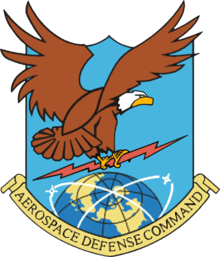
.svg.png)